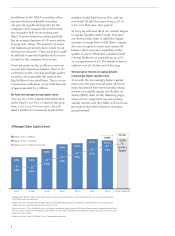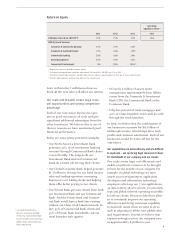JP Morgan Chase 2013 Annual Report Download - page 16
Download and view the complete annual report
Please find page 16 of the 2013 JP Morgan Chase annual report below. You can navigate through the pages in the report by either clicking on the pages listed below, or by using the keyword search tool below to find specific information within the annual report.-
 1
1 -
 2
2 -
 3
3 -
 4
4 -
 5
5 -
 6
6 -
 7
7 -
 8
8 -
 9
9 -
 10
10 -
 11
11 -
 12
12 -
 13
13 -
 14
14 -
 15
15 -
 16
16 -
 17
17 -
 18
18 -
 19
19 -
 20
20 -
 21
21 -
 22
22 -
 23
23 -
 24
24 -
 25
25 -
 26
26 -
 27
27 -
 28
28 -
 29
29 -
 30
30 -
 31
31 -
 32
32 -
 33
33 -
 34
34 -
 35
35 -
 36
36 -
 37
37 -
 38
38 -
 39
39 -
 40
40 -
 41
41 -
 42
42 -
 43
43 -
 44
44 -
 45
45 -
 46
46 -
 47
47 -
 48
48 -
 49
49 -
 50
50 -
 51
51 -
 52
52 -
 53
53 -
 54
54 -
 55
55 -
 56
56 -
 57
57 -
 58
58 -
 59
59 -
 60
60 -
 61
61 -
 62
62 -
 63
63 -
 64
64 -
 65
65 -
 66
66 -
 67
67 -
 68
68 -
 69
69 -
 70
70 -
 71
71 -
 72
72 -
 73
73 -
 74
74 -
 75
75 -
 76
76 -
 77
77 -
 78
78 -
 79
79 -
 80
80 -
 81
81 -
 82
82 -
 83
83 -
 84
84 -
 85
85 -
 86
86 -
 87
87 -
 88
88 -
 89
89 -
 90
90 -
 91
91 -
 92
92 -
 93
93 -
 94
94 -
 95
95 -
 96
96 -
 97
97 -
 98
98 -
 99
99 -
 100
100 -
 101
101 -
 102
102 -
 103
103 -
 104
104 -
 105
105 -
 106
106 -
 107
107 -
 108
108 -
 109
109 -
 110
110 -
 111
111 -
 112
112 -
 113
113 -
 114
114 -
 115
115 -
 116
116 -
 117
117 -
 118
118 -
 119
119 -
 120
120 -
 121
121 -
 122
122 -
 123
123 -
 124
124 -
 125
125 -
 126
126 -
 127
127 -
 128
128 -
 129
129 -
 130
130 -
 131
131 -
 132
132 -
 133
133 -
 134
134 -
 135
135 -
 136
136 -
 137
137 -
 138
138 -
 139
139 -
 140
140 -
 141
141 -
 142
142 -
 143
143 -
 144
144 -
 145
145 -
 146
146 -
 147
147 -
 148
148 -
 149
149 -
 150
150 -
 151
151 -
 152
152 -
 153
153 -
 154
154 -
 155
155 -
 156
156 -
 157
157 -
 158
158 -
 159
159 -
 160
160 -
 161
161 -
 162
162 -
 163
163 -
 164
164 -
 165
165 -
 166
166 -
 167
167 -
 168
168 -
 169
169 -
 170
170 -
 171
171 -
 172
172 -
 173
173 -
 174
174 -
 175
175 -
 176
176 -
 177
177 -
 178
178 -
 179
179 -
 180
180 -
 181
181 -
 182
182 -
 183
183 -
 184
184 -
 185
185 -
 186
186 -
 187
187 -
 188
188 -
 189
189 -
 190
190 -
 191
191 -
 192
192 -
 193
193 -
 194
194 -
 195
195 -
 196
196 -
 197
197 -
 198
198 -
 199
199 -
 200
200 -
 201
201 -
 202
202 -
 203
203 -
 204
204 -
 205
205 -
 206
206 -
 207
207 -
 208
208 -
 209
209 -
 210
210 -
 211
211 -
 212
212 -
 213
213 -
 214
214 -
 215
215 -
 216
216 -
 217
217 -
 218
218 -
 219
219 -
 220
220 -
 221
221 -
 222
222 -
 223
223 -
 224
224 -
 225
225 -
 226
226 -
 227
227 -
 228
228 -
 229
229 -
 230
230 -
 231
231 -
 232
232 -
 233
233 -
 234
234 -
 235
235 -
 236
236 -
 237
237 -
 238
238 -
 239
239 -
 240
240 -
 241
241 -
 242
242 -
 243
243 -
 244
244 -
 245
245 -
 246
246 -
 247
247 -
 248
248 -
 249
249 -
 250
250 -
 251
251 -
 252
252 -
 253
253 -
 254
254 -
 255
255 -
 256
256 -
 257
257 -
 258
258 -
 259
259 -
 260
260 -
 261
261 -
 262
262 -
 263
263 -
 264
264 -
 265
265 -
 266
266 -
 267
267 -
 268
268 -
 269
269 -
 270
270 -
 271
271 -
 272
272 -
 273
273 -
 274
274 -
 275
275 -
 276
276 -
 277
277 -
 278
278 -
 279
279 -
 280
280 -
 281
281 -
 282
282 -
 283
283 -
 284
284 -
 285
285 -
 286
286 -
 287
287 -
 288
288 -
 289
289 -
 290
290 -
 291
291 -
 292
292 -
 293
293 -
 294
294 -
 295
295 -
 296
296 -
 297
297 -
 298
298 -
 299
299 -
 300
300 -
 301
301 -
 302
302 -
 303
303 -
 304
304 -
 305
305 -
 306
306 -
 307
307 -
 308
308 -
 309
309 -
 310
310 -
 311
311 -
 312
312 -
 313
313 -
 314
314 -
 315
315 -
 316
316 -
 317
317 -
 318
318 -
 319
319 -
 320
320 -
 321
321 -
 322
322 -
 323
323 -
 324
324 -
 325
325 -
 326
326 -
 327
327 -
 328
328 -
 329
329 -
 330
330 -
 331
331 -
 332
332 -
 333
333 -
 334
334 -
 335
335 -
 336
336 -
 337
337 -
 338
338 -
 339
339 -
 340
340 -
 341
341 -
 342
342 -
 343
343 -
 344
344
 |
 |

1414
and will be devoted to this eort. In total,
it is hard to measure the overall scope and
investment since nearly all employees and
systems are engaged in some way or another.
We will be applying the new rules all the
way to the client level, the product level and
the trading desk
We will be applying the new rules, particu-
larly around capital, liquidity and the SLR
(and the factors that increase our capital
surcharge as a global systemically impor-
tant bank), all the way down to each client
we serve, each product we oer and each
trading desk we operate. Doing so will allow
our client executives as well as product and
trading managers to understand how the
new rules aect us at a very granular level
and allow our professionals to begin making
proper and compensating adjustments. At
the most basic level, some of these rules
conict with one another; for example, the
client may be profitable on Basel III capital
but not on SLR capital or vice versa. The
binding constraint at the client level may be
very dierent from the binding constraint at
the firmwide level. To be successful, we will
need to actively manage all these constraints
so we get a fair return on our capital and
properly manage our risks.
At the firmwide level, once we satisfy Basel
III capital, SLR capital and the Liquidity
Coverage Ratio, the binding constraints on
the firm may very well become the CCAR
test, the annual stress test from the Federal
Reserve Board. By its nature, the CCAR test is
less predictable because it will change every
year. And while you can’t eectively manage
stress testing at the client or product level, we
will manage it at the business level so that it
has more predictable outcomes, allowing for
more predictable capital planning.
We are big believers in stress testing, and
you should know that we do it all the time
and successfully conduct a large number of
dierent kinds of stress tests every week.
This enables us to eectively manage risk to
protect your company.
The new rules will have a major eect on
certain clients and products
All the new rules will not aect all clients
and all products equally. I obviously can’t
cover all client types and products, but I
would like to give some examples of those
that may be aected more than most – and
what that impact means for both JPMorgan
Chase and our clients.
Derivatives. Non-corporate users of deriva-
tives (asset managers, hedge funds, finan-
cial companies, governments, etc.) will have
to move all their standardized derivatives
(mostly interest rate and credit derivatives)
to exchanges, as opposed to handling them
directly with a bank. Corporate end users
of derivatives will be allowed to continue
to trade bilaterally with a bank. However,
for both of these segments, the cost to oer
derivatives to our various client groups will
increase due to capital, liquidity and margin
requirements imposed on us. It still remains
to be seen how all this will sort out.
Non-operational deposits. Essentially, these
are deposits that wholesale clients hold with
us that typically are short term and trans-
actional in nature. We take these deposits
more as a service to the client – not because
they are profitable for us. The new rules
require us to hold 100% of HQLA against
financial institution deposits and 40%
against non-financial corporate deposits. In
addition, based on current proposals, we
would have to hold 6% equity against the
assets we maintain for financial institutions
even if those assets consist of cash or other
low-risk assets such as government bonds.
This makes non-operational deposits hugely
